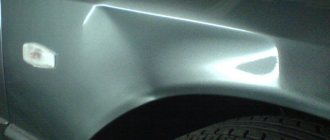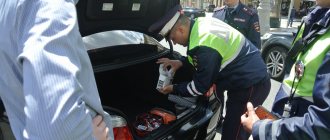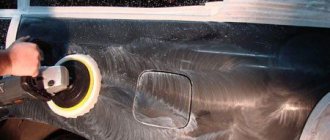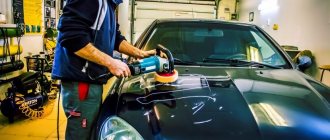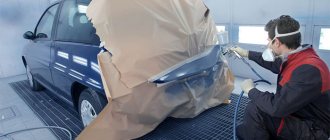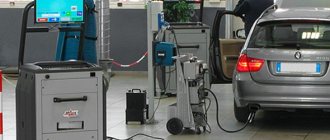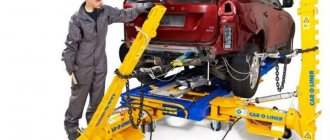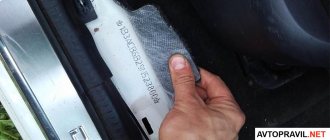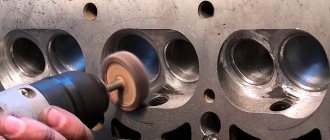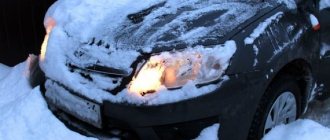Who needs to check the car body and when?
Checking the car body is quite a serious matter.
After all, by completing this procedure, you can know in advance about the susceptibility of your car to various kinds of “diseases”. You shouldn’t believe those who claim that it doesn’t matter what the body looks like. This statement is quite controversial, because this procedure will make it possible to find out what happened to this car earlier. Let us note that no repair, even the highest quality, can erase its history from the surface of a car. Most often, this check is resorted to when buying a car second-hand. This is certainly correct. After all, this is how you can find out whether to buy a given car or refrain from buying it.
The first step when checking the body is to inspect the bottom. It is this “part” that is primarily susceptible to rust and corrosion. Employees of almost all car service centers know that checking the underbody is necessary for the correct “diagnosis” and subsequent “treatment” of the car.
The main “diseases” of the body
Impact of corrosion - rust
If older cars did not have anti-corrosion coating, and such a defect was very often noticeable on used cars, then the body of a modern car undergoes factory treatment, and the manufacturer guarantees at least 5 years of operation without defects. Nowadays, deicing agents are widely used, especially in big cities. Also affected by: location and operating conditions, type of road surface. Rust, as a result of such exposure, can be seen by looking under the car and seeing rusty attached elements, such as a resonator, gas tank and engine protection against the background of a normal bottom.
If there are no particular problems with the attached parts, because they need to be changed during the operation of the vehicle, be sure to pay attention to problem areas of the body, such as sills, wheel arches, internal and external ends of the doors. These elements contain internal cavities, moisture accumulates in them and produces an effect from the inside. The consequence of this effect is swelling of the paintwork. If there are even small bubbles on the surface, the rust has already eaten the metal and come out, and the process of peeling off the paintwork has begun. You should not believe the seller’s assurances that this is a minor and inexpensive repair and buy such a car. With such repairs, rusty parts should be replaced and then the entire car should be painted or painted with a “spot”. Both procedures are quite expensive and you don’t need them, because the main task is to choose, buy and drive, and not buy and repair.
Rust on a car body
The reason for the appearance of rust on the body may be the car’s participation in a traffic accident, after which it was subjected to straightening and painting work. After straightening certain body parts, a layer of putty was applied to them and painting was done, which will certainly differ from the factory one. In addition, painting will be done only on one side, and accordingly, the protection against rust will be inadequate, and corrosion will take its toll.
Violation of body geometry - deformation as a result of mechanical impact.
Such a disease can occur both for reasons dependent on the owner of the car, for example, when hitting or colliding with a stationary and solid obstacle, and for reasons beyond their control, for example, when an emergency situation occurs during an accident. Very often, the cause of deformation is a rollover onto the roof, when the driver lost control and the car flew off the road while driving on a slippery road surface. A very important point is to determine the type of deformation, because this significantly affects the cost of the car.
In the video, checking to see if the car is damaged:
To get started, just check the body geometry . Check the car doors for opening and closing. The force and sound should be the same. If everything is fine, inspect all the cracks and gaps with the doors closed: they should be the same in width, and the doors should be recessed into their openings. If any door protrudes outward or is recessed deeper, it means that the body is distorted on the side of this door due to an external impact. Next, inspect the gaps and cracks between the hood and trunk lid and wings, check the level of headlights and taillights. If the difference in the cracks is obvious or the hood or trunk lid closes unevenly, we can talk about both a side impact and a front and rear impact, depending on which side the difference in the cracks is visible from. Additionally, you can draw conclusions about the condition of the side members.
Slightly damaged side members may not be fully straightened or left skewed, and the car simply will not be able to drive straight, at best. At worst, straightened and welded side members are a damaged power structure of the body, which can burst at the point of repair when driving in a loaded car or in the event of an emergency. You should watch how the seller reacts to your manipulations and how he negotiates . If it is ready to significantly increase in price due to the flaws you mentioned, you can safely leave such a car without attention, avoiding a catch. If the deformation of the body occurred naturally during operation and did not greatly affect the driving performance and safety, then you have a chance to save a lot on your purchase, of course, by visiting a service station for a more detailed check of the body.
Car body deformation
Poor quality of car paint.
To inspect the condition of the paint, you should choose daytime or good artificial lighting and, of course, a thoroughly washed car both outside and inside. A layer of dirt can hide rust stains or uneven paint finishes in color and quality without problems. If at the same time the seller offers to knock off a couple of hundred more from the attractive price, a hidden defect is guaranteed, and you will not avoid extra cash costs from a “successful” purchase. Feel free to ignore an offer to inspect a dirty car in the evening by the light of a street lamp or in a dark garage, even if the seller points out how busy it is during the day and an attractive price.
Carefully inspect the car for the presence of any non-factory paint, because it can be used to determine whether the car has been in an accident or not, whether rust has appeared on it and in what places.
After examining all the outer surfaces of the car body, you should see the same shade of paint. If any element is different in shade, make a note to yourself that it was painted.
Inspect the vehicle from the driver's and passenger's sides along the entire length of the body at the lower level of the door windows for dents, scratches and any flaws. Check the marked areas for sticking using a souvenir magnet. The magnet should stick equally to all places. If adhesion is worse in the places you marked, there is a place in front of you with a large layer of putty, a mark from the repair. If the magnet does not stick, then there is a hole in the marked area made by rust, filled with putty and painted on top. This is a poor renovation, the so-called pre-sale preparation, a place that after the autumn-winter season will turn into a new old hole.
Uneven body paint
In addition to rust, non-factory painting could have been done after the car was involved in an accident . Even if parts damaged in an accident are replaced with new ones, it is very difficult to achieve factory-quality paint, and resistance to corrosion will be much worse.
If there are no special comments, and only small chips from stones and small scratches are visible, then this problem can be solved easily and inexpensively. When polishing a car body at a service station, the body will be freed from numerous scratches and abrasions. Small chips can be primed and painted, and if everything is done correctly, you can forget about rust.
Stages of checking a car body. Checking the bottom
Checking the bottom begins with checking for the presence of mastic. If it is present, then this car is either applied over rust to hide it, or the previous owner used it to avoid corrosion. To check whether there is rust under the mastic, take a special tool and use it to pierce the bottom under the driver's seat.
It is important here to see whether it is difficult or easy to do. In the first case, if the manipulation is quite difficult, the conclusion is drawn that the bottom is “healthy”. But if the tool passes through the bottom easily (and even more so if not only under the driver’s seat), then we can safely say that this car can be driven for less than a year.
The consequences may be the seats falling through, the rear beam being torn off, which will lead to the rear wheels failing to function. In addition, it is advisable to check the underbody for other defects that often appear after accidents or during careless driving. Such defects often include additional welds or other defects.
Used car and body - correctly and reliably
So, we concluded in favor of purchasing a used car, saved up some money and got ready to choose a car. We read the advertisements, visited the market, scoured the Internet, selected several options - it’s time to start examining and choose the best option. Armed with a notepad, pen, and souvenir magnet, we proceed to a detailed inspection, starting with the body. Be careful and remember the following:
- A freshly painted car can almost always be identified by painted areas on the sealing rubber around the windows and optics, or by remnants of adhesive tape or paper under the bumper or in the lower part of the body. If painting was done on individual elements, this can be seen at an angle to the surface in daylight;
- the presence of a layer of putty both on the metal and with a repaired rust hole can be determined using a souvenir magnet;
- You can check the geometry of the body by inspecting, opening and closing doors, hood and trunk lids, checking cracks and gaps;
- inspect only a washed car, in daylight or good artificial light.
Stages of checking a car body. Body check
The next step in checking the body is checking the paintwork. For example, if there are scratches or other defects on the surface of the car, then you can safely knock off several thousand rubles from the price of this car, because subsequent repairs to the paintwork will be very expensive.
Of course, you can notice the dent yourself, but only a professional can distinguish between factory paint and service paint. Any specialist knows that when painting a car body, in some places under these layers of paint there is most often putty or even rust. This means that soon the paint in these places will begin to fall off, which will require additional investment.
Therefore, even if checking the car body by specialists will bring additional costs, it will allow you to avoid buying a car at too high a price, and will also save you from much higher costs for further repairs.
How to check the body?
To diagnose the condition of the car body, a paint thickness gauge will be very useful for you. The cheapest models cost from $40, but they have an error of about 0.1 mm. If you don't have this device, a small magnet wrapped in fabric will do. It should only be slightly magnetized to metal surfaces. It is important that the vehicle being inspected is clean. The inspection must be carried out in daylight. So, how to check a car before buying:
After moving a few steps away from the car, compare the color of all body elements. Inspect all sides of the car from different angles.
· Look under the rubber seals and compare the color of the paint underneath with the color of the rest of the parts.
· Inspect the outer surfaces of the car, looking at them lengthwise. With this method of inspection, bends and irregularities are very clearly visible. Also, the deformation of the reflected objects should attract your attention.
· Use a prepared magnet to check areas that cause suspicion. If it does not magnetize, it means there is a layer of putty under the paint.
· Check the thickness of the paint coating with a device. It must be the same on all body elements.
· Check for paint transitions, shagreen polishing or metal folds.
· If there are small chips, they should be uniform over the entire surface of the body. If they are not on any element, it means that it has been replaced or repaired.
· Compare the force and sound when closing each door. They should be the same. Otherwise, there is probably a violation of the body geometry.
· You can approximately check the geometry of the body using a string, comparing the distance between the control points.
· The width of the gaps between body elements must be the same everywhere.
· Check the bolts that secure the doors, hood and trunk. If they were unscrewed, it can be seen immediately.
· Inspect the welds and sealant layer. At the factory they are produced using automation, and no master can manually perform the work with the same quality.
· Check the manufacturing date of glass and lighting fixtures. The difference between the years of manufacture of these parts and the car itself should be no more than a year.
What affects the geometry of a car body?
Even if your car sits idle in the garage, its spare parts and components still wear out due to corrosion and other chemical processes. Other reasons due to which the body geometry changes include:
- Mechanical damage received during an accident (even a minor impact can seriously damage the frame). Off-road driving. Rough roads. Constant overload of the car as a result of transporting much more weight than indicated in the registration certificate.
Serious body deformation can lead to failure of key vehicle components, which will dramatically increase the cost of repairs.
Restoring body geometry
Please note that high-quality diagnostics of the car body, as well as measurement of its geometry, can only be carried out in service centers. Don’t believe various stories on forums about “Samodelkin” garage masters. Of course, such workers ask for much less money, and a visual inspection reveals a supposedly high-quality frame stretching and restoration. However, when building the body part of a car, engineers use special calculations, a slight violation of which leads to a deterioration in the controllability of the vehicle and, as a consequence, to the creation of an emergency situation. It is unlikely that you are willing to pay for a poorly carried out correction of body geometry with your health and the health of other people.
Complex work can only be carried out if there is a stand for restoring body geometry, equipped with a special electronic system. Such a device monitors the distance between control points in real time and promptly informs the master about the coincidence of real and reference indicators. In this case, alignment of the body geometry is carried out in a short time.
Please note that some parts may break when stretched. Others are made of plastic, and still others are generally unsuitable for cold or hot hoods. In this case, the cost of repairs can increase significantly.
There may be no electronic system that tracks performance. In this case, diagnosing the body geometry, as well as fixing the problem, will cost less. But due to the fact that the master will pull out the parts, as they say, by eye, the work will have to be completed much longer, and the metal of the spare parts will not be happy with such “dancing with a tambourine” when stretched.
